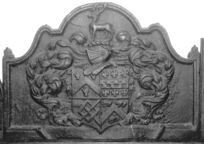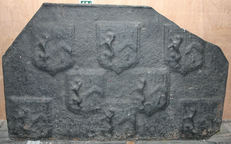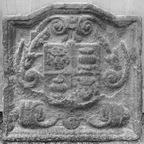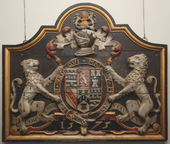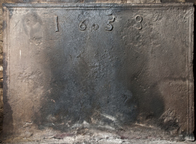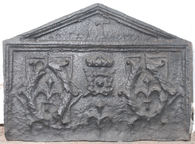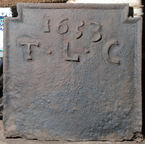-
141
Description: Arched rectangular shape; ovolo moulded edging; central oval shield of the arms of Penkhurst with fillet edge; date arranged in four corners.
Notes: The arms of Penkhurst: Argent, a fess ermines between six mullets sable. Probably the arms of Ferdinando Penkhurst, of Buxted Park, Sussex, who died in 1708. Formerly part of the Ade Collection (from Grove Hill, Hellingly, Sussex).
Inscription: 1707
Arms: Penkhurst, of Mayfield
- Decoration tags:
- rectangular with round arch (shape)
- ovolo (edging)
- whole carved pattern
- individual numbers
- armorial
- text
Manufactured: in 1707 in the Weald area of England.
Current location: Hastings Museum and Art Gallery, John's Place, Bohemia Road, Hastings, East Sussex, England.
Museum number: HASMG: 1952.51.46 (part of the Hastings Museum museum group)
Citation: Dalton, A., 2002, 'The Penkhurst family of ironmasters', Wealden Iron, 2nd ser., 22, pp. 23-26.
Citation: Lloyd, N., 1925, 'Domestic Ironwork I', Architectural Review, 58, pp. 58-67.
- Attached to series:
- Personal armorial firebacks
-
144
Description: Quasi-arched rectangular shaped with cyma recta curved shoulders and 'pinnacles'; ovolo moulded edging with a deep base panel; shield, helm, crest and mantling of the Maynard family; plain motto scroll below.
Notes: The arms, which are those of an esquire, can be identified from the first four quarters on the memorial to Raffe Maynard, d.1613, in St Albans Cathedral, son of John Maynard (d.1556); quarterly, 1, Maynard: argent, a chevron azure between three sinister hands couped at the wrist gules; 2, Filleigh: gules, a fess vairy between six crosses formy or; 3, Hewis: gules fretty argent a canton of the second; 4, Lyons: argent a chevron sable between three lions dormant coward gules; the crest, a stag statant, is of Maynard. Contemporaneously, there were Maynards who operated ironworks in the Rotherfield area in Sussex, with whom this fireback may be connected. Significantly the motto scroll is blank, suggesting that the wooden pattern for the fireback had been originally intended as a decorative panel with the motto painted rather than carved in relief. The top right corner of the shield was evidently broken on the original pattern prior to being impressed into the casting sand to form the mould. A smaller casting with the same arms is also known (no. 667). Formerly part of the Ade Collection (from Grove Hill, Hellingly, Sussex).
Copies of this fireback are known.
Arms: Maynard family
- Decoration tags:
- rectangular with round arch (shape)
- ovolo (edging)
- whole carved pattern
- armorial
Manufactured: in the late-16th to early-17th century in the Weald area of England.
Current location: Hastings Museum and Art Gallery, John's Place, Bohemia Road, Hastings, East Sussex, England.
Museum number: HASMG: 1952.51.14 (part of the Hastings Museum museum group)
-
151
Description: Canted rectangle; ovolo moulded edging (top and sides); eight shields of Ayloffe impaling Sulyard in three rows 3-2-3. Top right corner missing
Notes: Ayloffe: sable, a lion rampant Or, collared gules, between three crosses formy of the second; Sulyard: argent, a chevron gules between three pheons inverted sable. William Ayloffe (c1535-1584) of Bretons, Hornchurch, Essex, Justice of the Court of Queen’s Bench, married (c1560) Jane, dau. of Sir Eustace Sulyard, of Runwell, Essex. There is a large number of variants using the same shields. Formerly part of the Ade Collection (from Grove Hill, Hellingly, Sussex).
Arms: Ayloffe impaling Sulyard (William Ayloffe of Bretons, Hornchurch)
- Decoration tags:
- rectangular with canted top corners (shape)
- ovolo (edging)
- carved stamps
- armorial
Manufactured: in the early-17th century in the Weald area of England.
Current location: Hastings Museum and Art Gallery, John's Place, Bohemia Road, Hastings, East Sussex, England.
Museum number: HASMG: 1952.51.43 (part of the Hastings Museum museum group)
- Attached to series:
- Ayloffe series
- Personal armorial firebacks
-
165
Description: Rectangular with low, 3-facetted arch; ovolo edging; shield of the Goldsmiths’ Company: quarterly Gules and Azure, in the first and fourth quarters a Leopard's Head affrontée Or, in the second and third quarters a Covered Cup between in chief two Buckles fesswise all of the last; behind the shield is a scrolled escutcheon.
Notes: An unusually thick fireback. The Goldsmiths’ Company were granted arms in 1571.
Copies of this fireback are known.
Arms: Worshipful Company of Goldsmiths
- Decoration tags:
- rectangular with three-facetted arch (shape)
- ovolo (edging)
- whole carved pattern
- armorial
Manufactured: in the late-16th to early-17th century possibly in the Weald area of England.
Current location: Hastings Museum and Art Gallery, John's Place, Bohemia Road, Hastings, East Sussex, England.
Museum number: HASMG: 1978.15 (part of the Hastings Museum museum group)
- Attached to series:
- Livery company firebacks
-
926
Description: Carved wooden fireback pattern. Cavetto-canted rectangle with arch; ovolo-moulded edging; shield, garter, helm, mantling, crest, motto and supporters of William Cecil, 1st Lord Burghley, KG (1520-98). Date below garter.
Notes: William Cecil was Queen Elizabeth I's first minister. Owing to Lord Burghley's motto being merely painted and not carved, as the Garter motto is, the primary purpose of this armorial was probably decorative, and its role as a pattern for firebacks secondary.
Inscription: HONI SOIT QUI MAL Y PENSE / COR VNVM [ET] VIA VNA / 15 75
Arms: William Cecil, KG, 1st Baron Burghley
- Decoration tags:
- rectangular (shape)
- ovolo (edging)
- whole carved pattern
- planklines
- armorial
- text
Manufactured: in 1575 in England.
Current location: Hatfield House, Hatfield, Hertfordshire, England.
- Attached to series:
- Patterns
- Personal armorial firebacks
-
188
Description: Cavetto-canted rectangle with arch; ovolo-moulded edging; shield, garter, helm, mantling, crest and supporters of William Cecil, 1st Lord Burghley, KG (1520-98). Date below garter.
Notes: William Cecil was Queen Elizabeth I's first minister. The wooden pattern for this fireback (no. 926), itself a fine carved, wooden painted panel, is at Hatfield House, Hertfordshire.
Copies of this fireback are known.
Inscription: HONI SOIT QUI MAL Y PENSE 15 75
Arms: William Cecil, KG, 1st Baron Burghley
- Decoration tags:
- rectangular with canted top corners and round arch (shape)
- ovolo (edging)
- whole carved pattern
- planklines
- armorial
- text
Manufactured: in 1575 possibly in the Weald area of England.
Current location: Hatfield House, Hatfield, Hertfordshire, England.
- Attached to series:
- Personal armorial firebacks
- Armorial panel firebacks
-
939
Description: Rectangular with triangular top; ovolo-moulded edging; shield and crown of the French royal house of Valois, encircled by the collars of the orders of Saint Michel and Saint-Esprit
Notes: Cast no later than 1589 when the House of Valois was succeeded by the House of Bourbon.
Arms: France Royal
- Decoration tags:
- triangular arched (shape)
- ovolo (edging)
- whole carved pattern
- planklines
- armorial
Manufactured: in the late-16th century in France.
Current location: not known.
- Attached to series:
- Foreign armorial firebacks
-
950
Description: Rectangular shape; ovolo-moulded edging (top and sides); date top centre.
Notes: The style of the numerals is identical to those seen on another fireback, indicating a common source.
Inscription: 1658
- Decoration tags:
- rectangular (shape)
- ovolo (edging)
- carved stamps
- individual numbers
- text
Manufactured: in 1658 possibly at Tintern Furnace in the Forest of Dean area of Wales.
Current location: in private hands, Horsted Keynes, West Sussex, England.
- Attached to series:
- Date only firebacks
- 1640-50s Dean series
-
338
Description: Rectangular with pediment; ovolo moulded edging inside top of pediment and inside top and sides of rectangle; centre top, four-petal rose and crown with fleur de lys below; at either end, stamps made from two parts of a wreath (the middle section missing) enclosing a fleur de lys.
Notes: The wreaths from which the stamps have been disassembled can be seen complete on two other firebacks, and the rose and crown is a common stamp on a large series of early firebacks.
Inscription: ?I T
- Decoration tags:
- triangular arched (shape)
- ovolo (edging)
- carved stamps
- individual letters
- heraldic
- text
- objects
Manufactured: in the late-16th century in the Weald area of England.
Current location: in private hands Burford, Oxfordshire, England.
- Attached to series:
- Royal series
- Royal (wreath) series
-
339
Description: Rectangular with rebated top corners; ovolo moulded edging (top and sides); topcentre, date above initials.
Notes: The rebated corners are an unusual feature.
Inscription: 1653 / T · L ·C
- Decoration tags:
- rectangular (shape)
- ovolo (edging)
- individual letters
- individual numbers
- text
Manufactured: in 1653 in England.
Current location: in private hands, Huddington, Worcestershire, England.
- Attached to series:
- Date & initials firebacks

